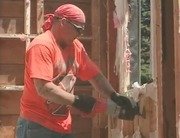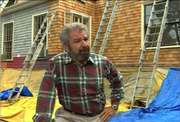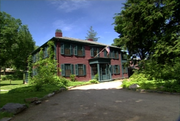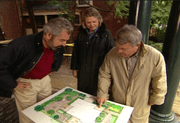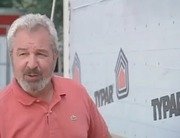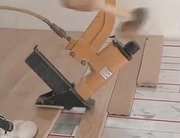I'm Bob Vila.
Welcome home again.
It's another rainy day in Cambridge and we are working outside we will show you how to install a beautiful blue stone terrace in the back of this house, also a trip to the Frederick Law Homestead historic site in Brookline, Massachusetts.
He was the famous nineteenth century landscape architect, who designed Central Park in New York City.
You'll also note this similarity in color between his house and my house.
And when we are back here, in the back yard again.
Construction of a retaining wall using Allen blocks.
Stick around, and it's good to have you home again.
Bob Vila's Home Again.
The challenging part of a landscape installation is what they call the hard scape which involves retaining walls and that is what we are building right here.
Lets get together with Mike, who is from all island supply down on Long Island, New York.
How are you?
You got a full crew here today.
Yeah.
Now what we are dealing here, rather than pouring a traditional retaining wall system with concrete is we're using this product called Allen block, right?
Right.
It's an interlocking concrete retaining wall system.
And so, it technically you can do a job like this, in a day if you've got a four man crew.
Everything has arrived and there's no concrete pouring at all, right?
You were just running this tamping machine here.
Right.
On what is essentially the footing for the retaining wall.
Exactly.
It's a recycled concrete product, that we use for the base to stabilize the ground.
So, its nothing more than (xx) from old sidewalks.
Correct.
That's it.
And then you don't have to worry about winter, or freezing and thawing.
Right, because the Allen block system is a flexible system.
As the ground, heaves and thaws in the freeze thaw cycles, the block will give and come back into it's normal position.
Yeah.
like a concrete retaining wall system which will crack from the force of the, the heaving.
And then you've got a crack.
Exactly.
Have you got the plans.
Sure.
So we understand what we're doing here.
I know we're creating a square retaining wall for what it is essentially a secondary level of terrace.
Here we go, this is, this is the back the deck and the house is back here.
And what we're doing is putting in a square retaining wall that will allow us to back fill and create a secondary level before we dig get down to the actual gray.
That's correct.
OK.
And so there's planting involved here too, right?
Correct.
There is, as a steps come down in this area over here.
There's going to be 2 planting areas.
One which is gone follow in an L-shape over into this direction,
Right.
And the same in L shape over here.
Right so that you literally don't see too much of the actual retaining wall at all, expect perhaps a little bit form the neighbor side.
Right, this is going to be a practical use retaining wall system.
Its really for the, for a
Its not an aesthetic thing?
Exactly.
Lets just watch them put it all together.
Now what kind of material is this, you're pouring in to the block?
Ok, this is a crushed stone product that we use and that happens to be one of the local stones, but there's depending on your location it could be a number of different products just to have drainage.
And it also helps in the locking of the block.
Great.
So we have been lucky enough to get Anthony Michael Landscaping from North Port, Long Island to come out and install all the allen block for us and it's looking pretty good.
Ok.
That sure makes quick work out of it.
Now there is no still reinforcing in any of these pieces right?
No, that's correct.
So, you just cut them freely.
Must be a pretty impressive sawThat goes there.
This fits right in.
Now, I was just noticing, as we laid this in, there's actually like a dove-tail joint here, isn't there?
Correct.
This business right here.
That's right.
And that's one of the keys in keeping this corner...
Together.
...together.
In fact, we have a corner over here that I could show you how is goes together.
Right.
That's nice.
All this is is regular dove-tail, just like you would with wood-working.
So in the casting it comes out nice and sharp like that.
Right, and you just slide them.
And you slide them into place.
And boy, that's just, that's not going to move anywhere.
Right.
That's great.
Now, this gets back-filled up to this height, which is basically a secondary terrace that we've created as a transition from the wood deck to the big terrace back there.
That's right.
And we were going to have a big planter in the middle, as well as the L-sheped planters, but I've changed my mind about them.
Middle we just wanna have the side planted.
But then here is where we need to have three steps, right.
Correct, it's gonna be probably four steps in this location right here.
Okay, and they will be blue stone.
Right they are going to be done in the blue stone, which will be on the top terrace here as well as lower terrace.
Okay, but this you know this is a very handsome a rusticated finish that you end up with, which I think is going to look very, very nice with that violet blue stone.
Alright, we really appreciate your efforts Mike its gonna be beautiful.
Okay.
Okay we're going to have to break for some messages.
When we come back we'll be visiting Frederick Law Olmsted's historic site in Brooklyn, Massachusetts.
Don't go away.

